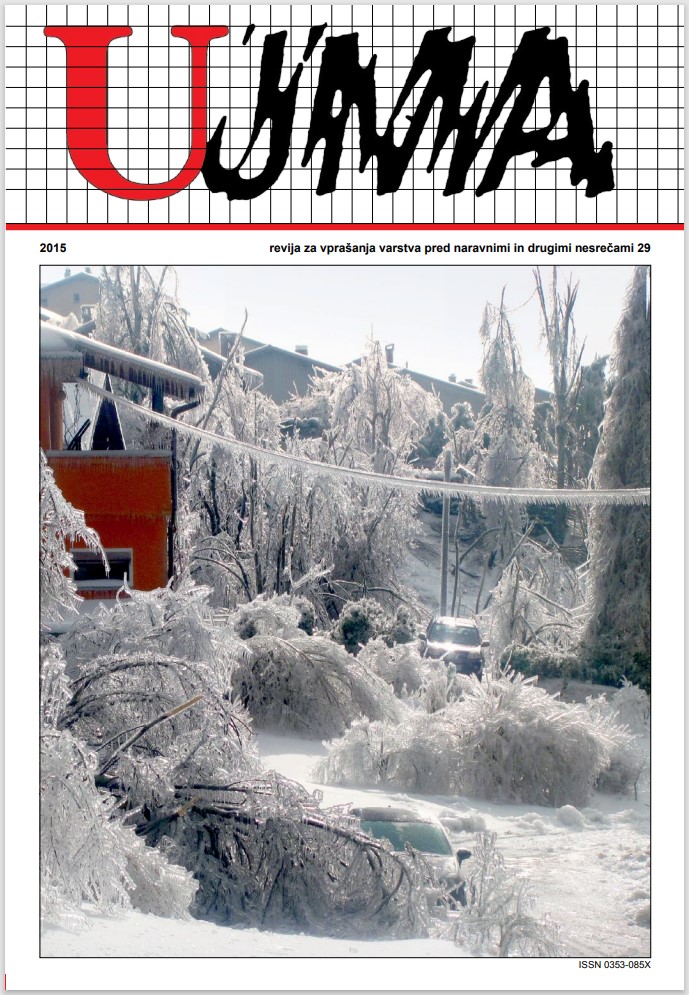POLLUTION OF URBAN SOIL IN IDRIJA
Abstract
The information, which is obtained using geochemical investigations of urban soils, is crucial to the estimation of risks that could threaten a healthy environment. Special attention is given to potentially harmful elements, which can, regarding their concentration, chemical form and type of intake or exposure, have a detrimental impact on living organisms, including human. Potentially harmful elements belong among dangerous inorganic substances, which accumulate in soil as a consequence of geogenic endowment (ore deposits) or anthropogenic influences (processes of mining and ore extracting, industry, traffic, etc.) and can present a risk to living organisms and ecosystems when their concentrations are enriched. An example of such an area in Slovenia is Idrija, our oldest mining town.
References
Bavec, Š., Gosar, M., Biester, H., Grčman, H., 2015. Geochemical investigation of mercury and other elements in urban soil of Idrija (Slovenia). Journal of geochemical exploration, sprejeto v tisk 4. 11. 2014.
Blum, W. E. H., Warkentin, B. P., Frossard, E., 2006. Soil, human society and the environment. V: Function of Soils for Human Societies and the Environment. London, Geological Society, 266, 1–8.
Cigale, M, 2006. Rudnik živega srebra Idrija od 1490 do 2006. V: 2. slovenski geološki kongres, Zbornik povzetkov. Rudnik živega srebra v zapiranju, d. o. o., Idrija, 13–16.
Drovenik, M., Pleničar, M., Drovenik, F., 1980. Nastanek rudišč v SR Sloveniji. Geologija, 1980, 23, 1, 1–57.
ES št. 1881/2006. Uredba komisije (ES) št. 1881/2006 z dne 19. decembra 2006 o določitvi mejnih vrednosti nekaterih onesnaževal v živilih (Besedilo velja za EGP), 14.
Gosar, M., in Šajn, R., 2001. Mercury in soil and attic dust as a reflection of Idrija mining and mineralization (Slovenia). Geologija, 44, 1, 137–159.
IPCS, 2001. International Programme on Chemical Safety. Arsenic and arsenic compounds, 2nd ed. Geneva, World Health Organization, (Environmental Health Criteria 224) http://whqlibdoc.who.int/ehc/WHO_EHC_224.pdf
Jenny, H., 1941. Factors of soil formation: A System of Quantitative Pedology. Canada, General Publishing Company, 264.
Johnson, C. C., Demetriades, A., Locutura, J., Ottesen, R. T., 2011. Mapping the Chemical Environment of Urban Areas. West Sussex, John Wiley & Sons, 616.
Kelly, J., Thorton, I., Simpson, P. R., 1996. Urban geochemistry: A study of the influence of anthropogenic activity on the heavy metal content of soils in traditionally industrial and non-industrial areas of Britain. Applied Geochemistry, 11, 363–370.
Lehman, A., Stahr, K., 2007. Nature and Significance of Anthropogenic Urban Soils. Journal of soils and sediments, 7, 4, 247–260.
Leštan, D., 2002. Ekopedologija, študijsko gradivo. Ljubljana, Biotehniška fakulteta, Oddelek za agronomijo, Katedra za pedologijo in varstvo okolja, 268.
Miklavčič, V., 1999. Mercury in the Town of Idrija (Slovenia) After 500 Years of Mining and Smelting. V Mercury Contaminated Sites: Characterization, Risk assessment and Remediation. Springer, Verlag Berlin Heidelberg New York, 259–270.
Miklavčič, A., Mazej, D., Jaćimović, R., Dizdarevič, T., Horvat, M., 2013. Mercury in food items from the Idrija Mercury Mine area. Environmental Research, 125, 61–68.
Mlakar, I., 1974. Osnovni parametri proizvodnje rudnika Idrija skozi stoletja do danes. Idrijski razgledi, 19, 3-4, 1–40.
Plumlee, G. S., Ziegler, T. L., 2003. The Medical geochemistry of Dusts, Soils, and Other Earth Materials. V Treatise on Geochemistry, Volume 9. Elsevier, 263–310.
Salminen, R., Batista, M. J., Bidovec, M., Demetriades, A., De Vivo, B., De Vos, W., Duris, M., Gilucis, A., Gregorauskiene, V., Halamic, J., Heitzmann, P., Lima, A., Jordan, G., Klaver, G., Klein, P., Lis, J., Locutura, J., Marsina, K., Mazreku, A., O’Connor, P. J., Olsson, S. Å., Ottesen, R. T., Petersell,V., Plant, J. A., Reeder, S., Salpeteur, I., Sandström, H., Siewers, U., Steenfelt, A., Tarvainen, T., 2005. Geochemical Atlas of Europe. Part 1 – Background Information, Methodology and Maps. Geological survey of Finland, 526.
Šajn, R., 2003. Distribution of chemical elements in attic dust and soil as reflection of lithology and anthropogenic influence in Slovenia. Journal de Physique, 107, 1173–1176.
Teršič, T., 2010. Okoljski vplivi starih žgalnic na Idrijskem: doktorska disertacija. Univerza v Ljubljani, 201.
Thornton, I., Farago, M. E., Thums, C. R., Parrish, R. R., Mcgill, R. A. R., Breward, N., Fortey, N. J. Simpson, P., Young S. D., Tye, A. M., Crout, N. M. J., Hough, R. L., Watt, J, 2008. Urban geochemistry: research strategies to assist risk assessment and remediation of brownfield sites in urban areas. Environmental Geochemistry Health, 30, 565–576.
Uradni list RS, 1996. Uredba o mejnih, opozorilnih in kritičnih imisijskih vrednostih nevarnih snovi v tleh. Ljubljana, Uradni list RS, 68, 5773–5774.
Ure, A. M., Berrow, M. L. The Elemental Constituents of Soils. V: Environmental chemistry, Volume 2, 94–204.
WHO. World Health Organisation. Elemental mercury and inorganic mercury compounds: Human health perspectives, 2003. < http://www.who.int/ipcs/publications/cicad/en/cicad50.pdf>.
Zupan, M., Grčman, H., Hodnik, A., Lobnik, F., Kralj, T., Rupreht, J., Šporar, M., Lapajne, S., Tič, I., Šijanec, V., Gogič, S., Mohorovičič, B., Ilc, R. and Kobal, M., 2008. Raziskave onesnaženosti tal Slovenije. Ljubljana, Agencija RS za okolje, 63.
Downloads
Published
Issue
Section
License

This work is licensed under a Creative Commons Attribution-NonCommercial-NoDerivatives 4.0 International License.
The articles are made available to the public under Creative Commons Attribution-NonCommercial-NoDerivatives 4.0 International (CC BY-NC-ND 4.0).


